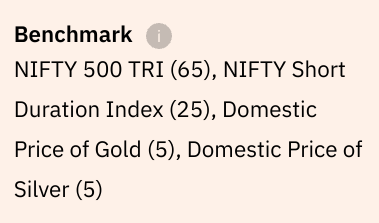Hybrid mutual funds are a little tricky to evaluate. Not only do you have to understand the strategy the fund will follow, but you also have to know the asset allocation that the fund will maintain. The fund’s scheme information document holds the authoritative answer for how the money is invested, but the benchmark chosen by the fund can give a quick hint on what to expect. I use benchmarks as an early signal to filter out funds that may not be suitable for my needs.
Let us look at a few examples of multi asset allocation funds. All the following screenshots are from ValueResearchOnline. I will not name the funds because identifying individual funds is not necessary for this exercise, and I don’t want to give unintentional signals (positive or negative) about any specific fund.
This is a popular mix of assets: 65% equity qualifies the fund to be taxed like equity. That may sound attractive to many investors, but I generally avoid such funds because I reach for hybrid funds only when I want to keep volatility low.
This is an interesting one, and honestly an appealing choice for me. This fund is well diversified with a global equity index and a commodity index added to the benchmark. (This is the first time I am even looking at this fund, actually.)
This is a simpler fund with just 3 asset classes in the benchmark. I also like that A-II debt is the largest asset class in the benchmark, which is a good hint that this fund will be less volatile than many of its peers.
While benchmarks give us a good hint on how the fund will invest our money, it is crucial to look at other sources of information, too. Reading the scheme information document, looking at the history of the fund (if available), and the history of the AMC (if available) can give us valuable information on what to expect from the fund.





No comments:
Post a Comment